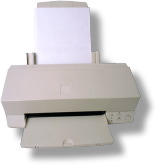Inkjet Printers
 At the heart of every inkjet printer, whether it is a color printer or just B&W, there is an ink cartridge that gets shuttled back and forth across the page, leaving a trail of letters or colors. Upon closer inspection, however, it becomes clear that there is much more to this cartridge than meets the eye. At the bottom of the cartridge, facing the paper, is a small, shiny, rectangular area called the 'printhead' which can be seen using a magnifying glass to contain an array of very tiny holes or orifices. If one could become small enough to watch the space between the printhead and the paper as the cartridge shoots back and forth across the page one would see tiny jets of ink droplets spraying out of these orifices. The cartridge also has a rather complex-looking printed circuit that interfaces with a multi-strand ribbon cable. At the other end of the ribbon cable is some electronic circuitry. This circuitry controls the printhead of the cartridge.
At the heart of every inkjet printer, whether it is a color printer or just B&W, there is an ink cartridge that gets shuttled back and forth across the page, leaving a trail of letters or colors. Upon closer inspection, however, it becomes clear that there is much more to this cartridge than meets the eye. At the bottom of the cartridge, facing the paper, is a small, shiny, rectangular area called the 'printhead' which can be seen using a magnifying glass to contain an array of very tiny holes or orifices. If one could become small enough to watch the space between the printhead and the paper as the cartridge shoots back and forth across the page one would see tiny jets of ink droplets spraying out of these orifices. The cartridge also has a rather complex-looking printed circuit that interfaces with a multi-strand ribbon cable. At the other end of the ribbon cable is some electronic circuitry. This circuitry controls the printhead of the cartridge.
What makes it work is the ingenious application of a very interesting electrical property, easily demonstrated in your bathroom sink using a plastic comb, a thin stream of water from the faucet, and your head. Pass a clean comb through your clean, dry hair several times, then bring the comb carefully toward the little stream of water coming form the faucet. You should see the water stream bend toward the comb as it gets closer. Electrical attraction between the highly polar water molecules and the excess static electrical charge built up on the comb is the cause of this effect. Ink from the printer cartridge is propelled onto the paper in a similar way. The tiny orifices in the printhead of the cartridge are too small for the ink to flow through freely. But when they are electrically activated ink is drawn through them and out the other side in a jet of tiny bubbles or droplets.
The electronics in the printer contain programming that precisely controls the charging and discharging of each tiny orifice in a pattern that produces either text letters or color patterns. When a file is sent from the computer to the printer, it is sent as a digital code identifying the identity, order, case, font face, and font size of the text letters, or the order and color properties of each pixel in an image file. The operating program of the printer takes this code and coordinates it with the control patterns of the orifices in the printhead. Then, as the cartridge shuttles across the page, the ink jets reproduce the file code as a spray of ink droplets onto the surface of the paper, line by line. The codes used are binary in form, represented by a series of 1's and 0's. One value turns an orifice on, the other value turns it off. This can be repeated thousands, even millions of times per second, allowing words and pictures to appear on the page very quickly as if by magic.
About the Author
Richard M J Renneboog, MS
 Richard M. J. Renneboog is an independent private technical consultant and writer in both chemical and computer applications. Endeavors have included preparation of scripts for instructional and promotional video, corporate website design, curriculum development for training in advanced composites technology, and development.
Richard M. J. Renneboog is an independent private technical consultant and writer in both chemical and computer applications. Endeavors have included preparation of scripts for instructional and promotional video, corporate website design, curriculum development for training in advanced composites technology, and development.


